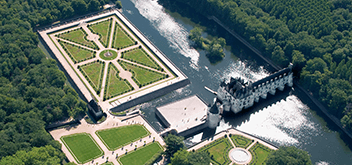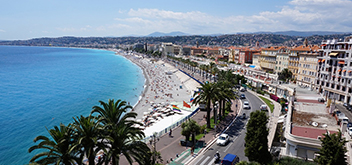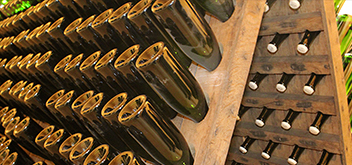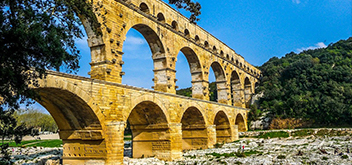No products
SOME OF THE 400 CHATEAUX OF THE LOIRE VALLEY
PAGODE DE CHANTELOUP
Pagoda of Chanteloup is located in a 14 hectares wide French style garden. This monument of Chinese inspiration but purely belonging to the Louis XVIth style, of great originality and architectural audacity. 44 meters high, has is a staircase inside giving access to one of the most beautiful panoramas of the Touraine region where your eyes can wander on the beauties of the Loire Valley as well as the forest of Amboise.
CHATEAU D'USSE
 The Chateau d'Ussé is "the Sleeping Beauty's Chateau" It is the very image of a beautiful castle, the one which inspired poets and authors of fairy tales: built with the local limestone, with a multitude of roofs, pinnacles, dormer windows, and chimneys. You will discover: the guardroom, the former chapel, the large gallery with many tapestries, and king's bedroom hung with red silk and lovely Louis XVIth style furniture. Inside the keep, be enchanted by the Tale of the Sleeping Beauty with the famous Wicked Witch and Princess... and Prince Charming. Indeed, Charles Perrault, author of this tale, was inspired by the château when writing this famous story.
The Chateau d'Ussé is "the Sleeping Beauty's Chateau" It is the very image of a beautiful castle, the one which inspired poets and authors of fairy tales: built with the local limestone, with a multitude of roofs, pinnacles, dormer windows, and chimneys. You will discover: the guardroom, the former chapel, the large gallery with many tapestries, and king's bedroom hung with red silk and lovely Louis XVIth style furniture. Inside the keep, be enchanted by the Tale of the Sleeping Beauty with the famous Wicked Witch and Princess... and Prince Charming. Indeed, Charles Perrault, author of this tale, was inspired by the château when writing this famous story.
ANGERS
Fortress built by young Saint Louis on the edge of his kingdom in 13th Century... Cross the drawbridge and inside the castle walls you will find the pleasant residence of the Dukes of Anjou, composed of buildings constructed at the end of the gothic era and gardens. Other marvels await you, amongst which the highly exceptional Apocalypse tapestry, the largest medieval tapestry known to exist (it is 104 metres long), and the famous mille-fleurs and Passion tapestries...
Situated on a Gallo-Roman site, around the palace of the first counts of Anjou, who belonged to the Plantagenêt dynasty, the fortress of Angers dominates the city with its 17 towers built by Saint Louis between 1230 and 1240. It was one of the most formidable military constructions in the kingdom of France, and it still remains the best preserved one in the north of the Loire river. In the 14th and 15th centuries, the dukes of Anjou settled their princely court there. Just like that of Burgundy or Berry, the court of Anjou exerted its influence over the political and artistic life of the kingdom of the De Valois family. It succumbed to first Italian influences of the Renaissance, as one can see in the Logis Royal gallery (royal suite). The castle was made yet more beautiful by the king René in the 15th century. After being threatened of destruction during the wars of religion, the stronghold was transformed by the governor Donadieu de Puycharic, who fitted out artillery terraces on the former curtain walls. A new presentation was created in the gallery of the castle in order to preserve the very famous tapestry of the Apocalypse. This masterpiece is more than 100 metre long and 6 metre high. It was woven for the duke Louis I of Anjou towards 1735 and then bequeathed to the Saint-Maurice cathedral by the king René of Anjou. It is the most famous medieval tapestry.
LOCHES
The keep of the castle of Loches was built in the early 11th century by Foulques Nerra. Thirty-six metre high, it is one of the most impressive buildings of the Norman period. Fine example of military architecture, it was later converted into a prison. One of its most famous inmates was Ludovic Sforza, duke of Milan.
The Royal Apartments are a significant example of the French Renaissance. The façade opening onto the terrace dominates the historic city and the Indre Valley. Loches is marked by the presence of famous women of the French history, such as Joan of Arc, Agnes Sorel and Anne of Brittany.
LANGEAIS
 Around 1000, two powerful local lords were fighting for the Touraine: the Count of Anjou, Foulque Nerra, and the Count of Blois, Eudes I. At the end of the 10th century, Foulques Nerra conquered the site of Langeais, not far from Tours, and established a castle on the promontory. All that remains of it now are a few traces of the keep. For the next four decades, Langeais went through troubled times, occupied turn and turn about by the successive Counts of Blois and Anjou. Finally, in 1044, along with the rest of Touraine, it fell into the hands of the Plantagenets and then of their descendants who were the Kings of England. It was not until 1206 that Langeais became part of the French realm, after the victories of Philippe Auguste (King Philippe II) over England's King John. Thereafter, its possession was conferred on various great lords close to the French court.
Around 1000, two powerful local lords were fighting for the Touraine: the Count of Anjou, Foulque Nerra, and the Count of Blois, Eudes I. At the end of the 10th century, Foulques Nerra conquered the site of Langeais, not far from Tours, and established a castle on the promontory. All that remains of it now are a few traces of the keep. For the next four decades, Langeais went through troubled times, occupied turn and turn about by the successive Counts of Blois and Anjou. Finally, in 1044, along with the rest of Touraine, it fell into the hands of the Plantagenets and then of their descendants who were the Kings of England. It was not until 1206 that Langeais became part of the French realm, after the victories of Philippe Auguste (King Philippe II) over England's King John. Thereafter, its possession was conferred on various great lords close to the French court.
BEAUREGARD
 The Chateau of Beauregard (16-17th) is a former hunting lodge of Francois 1. This château is remarkable for its portrait galley, the biggest in Europe with 327 historical portraits. The floor tiles in this gallery, in blue Delft ceramic, represent an army in march and rival the ceiling, painted with powder of lapis-lazuli, a stone that was worth 10 times a kilo of gold...
The Chateau of Beauregard (16-17th) is a former hunting lodge of Francois 1. This château is remarkable for its portrait galley, the biggest in Europe with 327 historical portraits. The floor tiles in this gallery, in blue Delft ceramic, represent an army in march and rival the ceiling, painted with powder of lapis-lazuli, a stone that was worth 10 times a kilo of gold...
CHATEAU DE TALCY
15-16th century château. Built in 1520 for an Italian banker, Bernard Salviati, this château is furnished with its 18th century furniture. A well, grounds with wine press and pigeon keep, and the conservatory orchard highlight the agricultural character of the property. Many important literary figures haunt this place: Ronsard, smitten with Cassandra, the daughter of Bernard Salviati. It was she who inspired the famous poem "Mignonne, allons voir..., the poet Agrippa d'Aubigné, who loved Diane, the niece of Cassandre, in 1570. The Stapfer family lived at Talcy in the 19th century.
TROUSSAY
A typical gentleman's residence in the Loire Valley and Sologne style, the Chateau of Troussay is stll inhabited, furnished, and richly decorated. Beautiful décoration throughout the chateau- stone sculptures on the façade and the fireplaces, delicated woodwork on the doors and windows, painted ceilings, Renaissance stained-glass windows, cast-iron fireplaces plates, and antique keys, as well as 16th 17th, and 18th century furniture. The picturesque outbuildings have antique wood beams that recall the Sologne of old. You will find a small museum of Sologne arts and traditions.
VILLESAVIN
The elegant Villesavin château, located in Tour-en-Sologne (17 kilometers from Blois), belonged to Jean the Breton, François the First's finance minister and head of construction work at Chambord. Built by the master craftsmen that built Chambord, the Chateau still shows beautiful pieces: a Carrarra marble sink in the main courtyard, or a pigeon keep with a revolving ladder and 1,500 nests. You will visit two museums during your tour. The first shows you animal-drawn vehicles and the second marriage customs from the 19th century.
CHEMERY
Chateau (13th-15th-16th centuries) from the transition between the Feudal era and the Renaissance, under restoration since 1981, it is inhabited and it is a living example of preservation. A collection of engravings unique in France (large format) on the history of dress from the 4th to 19th centuries is an added pleasure during your tour.
FOUGERES SUR BIEVRE
15th-16th century medieval Chateau. Very typical, this small Chateau belonged to the treasurer of Louis 11th, who wanted to make of it a defence Chateau. Later, his son-in-law gave it a more comfortable aspect. A remarkable example of military architecture, the Chateau of Fougères-sur-Bièvre is worth the trip. Its massive appearance is softened by numerous towers and an underground river.
MANOIR DE LA POSSONIERE
Birthplace of Pierre de Ronsard (16th century). The prince of poets was born here on 10 September 1524, and lived here for the first twelve years of his life. Decorated with sculptures and mottoes, La Possonnière Manor is really charming, in the image of the mark that the famous Poet left on French literature.
CHATEAU DE GUE PEAN
A Renaissance wonder in a green setting, this quadrilateral château surrounded by corner towers with domes and lanterns, one of which houses the chapel, the largest being machicolated, curtain wall, the main building with a square wing, main courtyard, 2 Renaissance pavilions, a beautiful monumental fireplace from the early 17th century.
DOMAINE DE MONTIGNY LE GANNELON
This richly decorated and furnished Renaissance château overlooks the Loire Valley. A pupil of Violet-le-Duc built east façade. In 1834, the Prince Duke of Montmorency-Laval, ambassador of France, constructed an additional wing onto the Chateau.
MONTLIVAULT
Located on the edge of the right bank of the Loire, up-stream from Blois, Montlivault has a priviliged position and has an exceptional view on the Loire river bank. The town had its golden age at the beginning of the 16th century, as you can see by the size of its Chateau built at this period. This remarkable building was built around 1610.
MONTMIRAIL
This medieval fortress houses an underground arms room and a 15TH century dungeon, as well as an 18th century sitting room, dinning room, and ice box. The park gives a panoramic view.
CHATEAU DE MONTMARIN
A lovely 17th-century residence in the Perche style and overlooking La Braye Valley is built by a wood.
CHATEAU DES RADRETS
Located in a green setting, the chateau (15th-16th-18th centuries) is built on a quadrilateral layout of ditches and still has three corners, its original bastions and its fortifications from the 16th and 17th centuries. It is connected to the old 14th-century manor by a bridge. Inside, the rooms are a testimony to the military architecture with the imposing equipment in roussard stone (red sandstone traditionally used in building in the Perche region). Its fortified farm, made up of towers, a dovecot and a huge barn with its inverted ship frame, round off this magnificent set of buildings
CHATEAU DE ROCHAMBEAU
This site has been owned by the family since 1516; the château was expanded by Maréchal de Rochambeau who made a name for himself in the American War of Independence. It is in a particularly pleasant, picturesque site on the banks of the Loir, and the grounds have a surprising alleyway of century-old linden trees. Comprising a renovated main building, with two pavilions on either side, a Mansard roof, period woodwork, a main courtyard surrounded by superb outbuildings pressing up to the rock of the hillside, a chapel, a horseshoe staircase, etc. It is also furnished and contains memorabilia from the Maréchal. The central part of the château dates from the 16th century, the two surrounding pavilions from the 18th century.
RUINS OF THE CHATEAU OF VENDOME
Ruins of the 12th-15th-century chateau: this old chateau of the Bourbon-Vendôme family can be imagined through its remains, including the Tower of Poitiers. The grounds are a pleasant opportunity to relax, with their garden and beautiful view on the town.


















